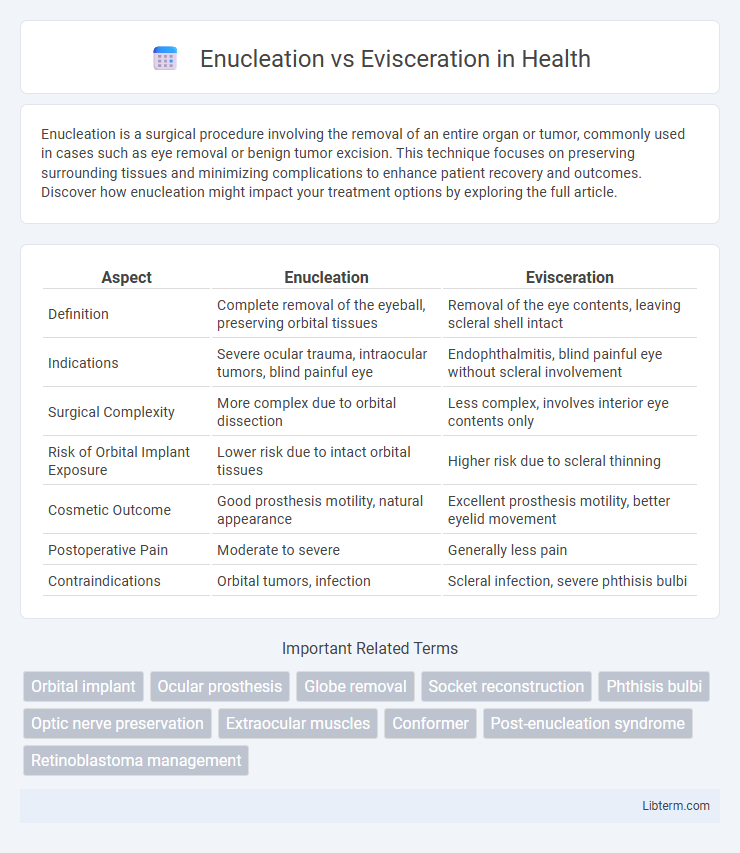Enucleation is a surgical procedure involving the removal of an entire organ or tumor, commonly used in cases such as eye removal or benign tumor excision. This technique focuses on preserving surrounding tissues and minimizing complications to enhance patient recovery and outcomes. Discover how enucleation might impact your treatment options by exploring the full article.
Table of Comparison
| Aspect | Enucleation | Evisceration |
|---|---|---|
| Definition | Complete removal of the eyeball, preserving orbital tissues | Removal of the eye contents, leaving scleral shell intact |
| Indications | Severe ocular trauma, intraocular tumors, blind painful eye | Endophthalmitis, blind painful eye without scleral involvement |
| Surgical Complexity | More complex due to orbital dissection | Less complex, involves interior eye contents only |
| Risk of Orbital Implant Exposure | Lower risk due to intact orbital tissues | Higher risk due to scleral thinning |
| Cosmetic Outcome | Good prosthesis motility, natural appearance | Excellent prosthesis motility, better eyelid movement |
| Postoperative Pain | Moderate to severe | Generally less pain |
| Contraindications | Orbital tumors, infection | Scleral infection, severe phthisis bulbi |
Introduction to Enucleation and Evisceration
Enucleation involves the complete removal of the eye globe while preserving the surrounding orbital tissues, primarily used in cases of severe trauma, malignancy, or uncontrollable pain in a blind eye. Evisceration entails removing the eye's contents but leaving the scleral shell and extraocular muscles intact, often preferred for less invasive procedures with better prosthesis movement. Both surgical techniques aim to address different clinical indications, weighing factors like infection risk, cosmetic outcomes, and preservation of orbital anatomy.
Definitions and Key Differences
Enucleation involves the surgical removal of the entire eye globe, including the sclera, while preserving the surrounding orbital tissues. Evisceration entails removing the eye's contents but leaving the sclera and extraocular muscles intact, allowing for better prosthetic motility. Key differences include the extent of tissue removal and postoperative prosthesis movement, with enucleation often indicated for intraocular tumors and evisceration preferred in cases of endophthalmitis or trauma without tumor presence.
Indications for Enucleation
Indications for enucleation primarily include severe ocular trauma, intraocular tumors such as retinoblastoma or melanoma, and painful blind eyes refractory to other treatments. This surgical procedure involves the removal of the entire eyeball while preserving the surrounding orbital tissues, distinguishing it from evisceration, which removes only the intraocular contents. Enucleation is preferred when there is a risk of tumor spread or when the eye is non-functional and painful with no potential for visual recovery.
Indications for Evisceration
Evisceration is primarily indicated in cases of severe ocular trauma, endophthalmitis, or painful blind eyes where the sclera remains intact, allowing for the removal of intraocular contents while preserving the outer eye structure. This procedure is preferred over enucleation when there is no suspicion of intraocular malignancy and the surrounding tissues are healthy. Evisceration offers better cosmetic outcomes and easier prosthetic fitting compared to enucleation in appropriate clinical scenarios.
Surgical Techniques Compared
Enucleation involves the complete removal of the eye globe while preserving the surrounding orbital tissues, whereas evisceration entails removing the ocular contents but leaving the scleral shell and extraocular muscles intact. Enucleation requires careful dissection of the optic nerve and extraocular muscles, often leading to greater orbital volume loss, while evisceration is less invasive, preserving orbital anatomy and resulting in faster postoperative rehabilitation. Surgical choice depends on indications such as trauma, infection, or malignancy, with enucleation favored for intraocular tumors and evisceration preferred for painful blind eyes without intraocular tumors.
Risks and Complications
Enucleation carries risks such as hemorrhage, orbital implant migration, and scleral thinning, with potential complications including socket contracture and ptosis. Evisceration poses risks of sympathetic ophthalmia, persistent inflammation, and implant exposure, which may lead to socket infection or extrusion. Both procedures require careful postoperative monitoring to minimize complications and ensure optimal ocular prosthesis fitting.
Benefits and Drawbacks of Each Procedure
Enucleation involves removing the entire eyeball while preserving surrounding orbital tissues, offering definitive treatment for malignant tumors and severe trauma but resulting in more extensive surgery and longer recovery time. Evisceration removes only the eye's contents, maintaining the scleral shell and extraocular muscles, which often leads to better prosthetic motility and shorter healing periods but carries a higher risk of orbital infection if underlying disease is present. Choosing between enucleation and evisceration depends on factors such as the presence of intraocular malignancy, infection risk, and the patient's need for optimal cosmetic and functional outcomes.
Postoperative Care and Recovery
Postoperative care after enucleation involves managing orbital implant integration, pain control, and preventing infection through antibiotic eye drops, with typical recovery lasting 4-6 weeks for socket healing. Evisceration recovery emphasizes preserving the scleral shell while monitoring for inflammation and infection, usually resulting in faster healing times of 2-4 weeks. Both procedures require close follow-up with ocularists for prosthesis fitting, ensuring optimal cosmetic outcomes and socket motility.
Patient Outcomes and Satisfaction
Enucleation involves the removal of the entire eyeball, leading to a higher risk of volume loss and socket contracture, which can affect prosthetic fitting and long-term patient satisfaction. Evisceration preserves the scleral shell and extraocular muscles, typically resulting in better prosthetic motility and improved cosmetic outcomes, contributing to increased patient satisfaction. Studies indicate that patients undergoing evisceration report fewer complications and enhanced quality of life compared to enucleation, making it the preferred choice when appropriate.
Choosing the Optimal Procedure
Choosing the optimal procedure between enucleation and evisceration depends on the underlying ocular pathology and the need for complete globe removal. Enucleation involves the removal of the entire eyeball, including the sclera, and is preferred in cases of intraocular malignancies or severe trauma to prevent orbital cellulitis and sympathetic ophthalmia. Evisceration removes only the intraocular contents while preserving the scleral shell, often resulting in better cosmetic outcomes and implant motility for cases without extensive orbital disease.
Enucleation Infographic

 libterm.com
libterm.com